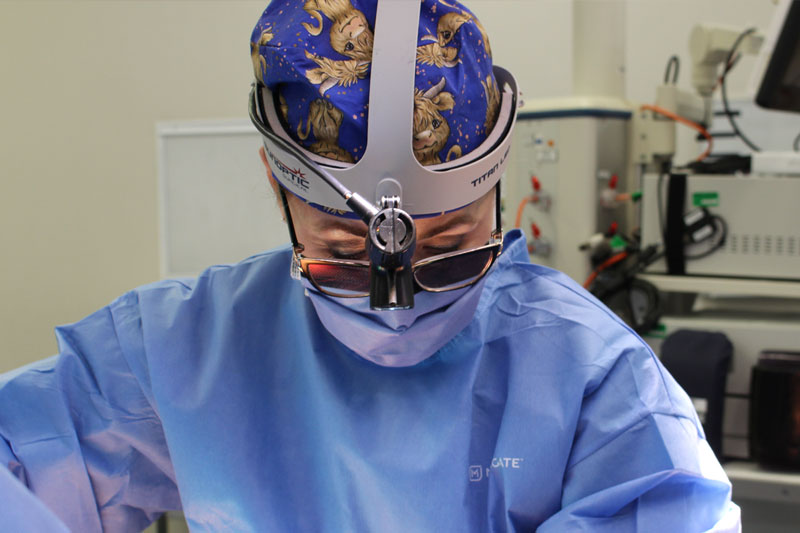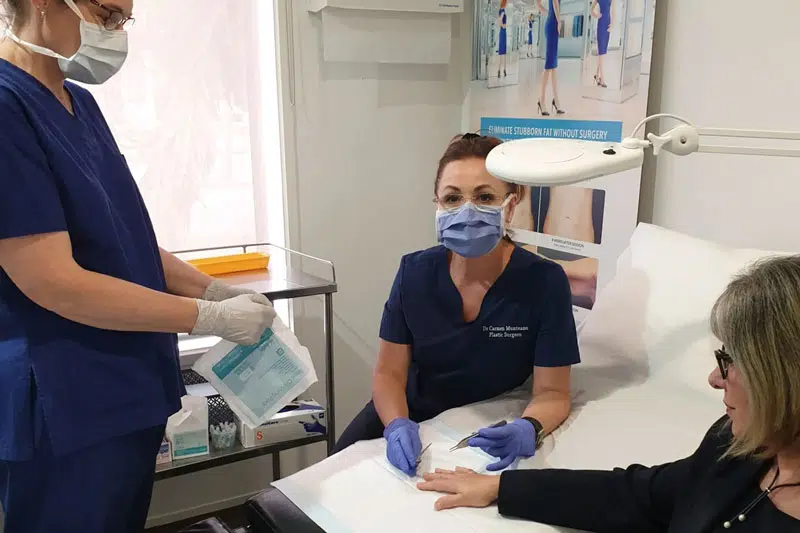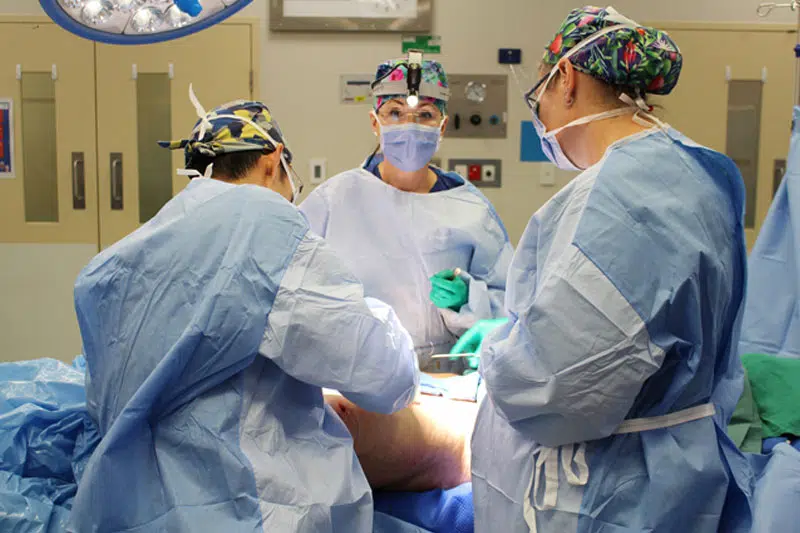What is a Labiaplasty?
Labiaplasty is a type of plastic surgery procedure that involves modifying the labia minora (inner lips) and/or labia majora (outer lips) to alter their appearance or alleviate physical discomfort. This procedure, also known as labia minora reduction or labial reduction, aims to alter the appearance and functional vulva. By addressing issues such as excess tissue or asymmetry, Labiaplasty may help reduce irritation, increase hygiene, and comfort during various activities.
As a form of cosmetic genital surgery, Labiaplasty offers potential functional and aesthetic benefits, tailored to meet the unique needs of each patient.
Download Dr Carmen’s Guide to
Labiaplasty
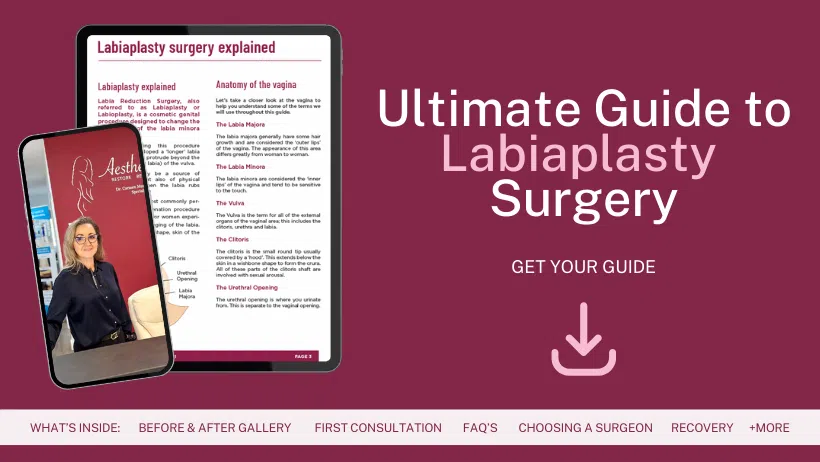
Labiaplasty Surgery in Melbourne Victoria by Female Plastic Surgeon Dr Carmen
When considering Labiaplasty surgery, it is essential to find a skilled and qualified plastic surgeon who can provide personalised care and achieve results aligned with your individual goals. Dr Carmen Munteanu is a female Specialist Plastic Surgeon with extensive qualifications, experience, and a commitment to compassionate, patient-centered care. She offers a unique balance of understanding, empathy, and surgical experience, making her a great choice for patients seeking Labiaplasty.
At Aesthetik Profile, Dr. Munteanu works closely with her patients to address their individual concerns, whether the goal is to increase functionality, address discomfort, or alter the appearance. Many patients find that having a female surgeon provides an added sense of comfort, especially when discussing sensitive and personal matters or undergoing intimate procedures, like Labiaplasty Surgery. Dr Munteanu provides a supportive and respectful environment, making sure patients feel heard and understood throughout their surgical journey.
By tailoring every procedure to meet the unique needs of her patients and adhering to the highest medical standards, Dr Carmen Munteanu provides dedicated care to those considering Labiaplasty, delivering results designed to alter both form and function.
Am I a Good Candidate for a Labiaplasty?
Labiaplasty may be a suitable option for individuals who experience discomfort, pain or dissatisfaction related to the appearance or size of their labia. While every patient’s needs are unique, there are several factors that can help determine whether Labiaplasty is appropriate for you:
- Physical Discomfort: If you experience discomfort during activities such as exercise, sexual intercourse, or wearing tight clothing due to enlarged or asymmetrical labia, Labiaplasty may help alleviate these symptoms.
- Altered Appearance: Individuals who are concerned about the aesthetic appearance of their inner labia may also consider Labiaplasty as a means to change its appearance.
- Realistic Expectations: Suitable candidates should have realistic expectations about the outcomes of the procedure. Labiaplasty can change the appearance and comfort of the labia, but it may not change other aspects of genital appearance or sexual function.
- No Underlying Health Issues: Candidates should be in overall good health, free from conditions that may affect healing, such as infections or certain chronic conditions. It is essential that you are not pregnant or planning to be pregnant in the near future.
- Fully Developed Genitalia: Since Labiaplasty is not typically recommended for women under the age of 18, it is important that the genitalia is fully developed before considering the procedure.
- Non-Smoking: Smoking can interfere with healing and increase the risk of complications. It is important to be a non-smoker or to quit smoking well in advance of surgery.
It’s essential to have a detailed consultation with a qualified, experienced surgeon to discuss your individual concerns, goals, and overall health. Dr Carmen will provide personalised advice to determine whether Labiaplasty is a suitable option for you and help you make an informed decision.
Reasons to consider Cosmetic Genital Surgery
Labiaplasty surgery is a highly personal decision and there are several potential reasons why individuals may seek it. Some of the reoccurring reasons individuals consider Labiaplasty include:
- Physical Discomfort or Pain: One of the primary reasons individuals seek Labiaplasty is to alleviate discomfort or pain caused by enlarged or asymmetrical labia. This can occur during activities such as sexual intercourse, exercise, or wearing tight clothing, which can result in irritation or chafing.
- Aesthetic Concerns: If an individual is dissatisfied with the size, shape, or symmetry of their labia. Labiaplasty may offer a more aesthetically pleasing outcome. This surgery focuses on reducing excess tissue and leaving a more proportionate labia. The trim procedure is a widely used technique performed by surgeons, where excess labia minora is removed and sutured to achieve symmetry with the labia majora.
- Post-Childbirth Changes: Childbirth can sometimes result in changes to the labia, including stretching or elongation. Labiaplasty may be an option for individuals seeking to alter the appearance of the labia so it aligns closer to its pre-pregnancy state or alleviate physical discomfort following childbirth.
- Sexual Comfort: Enlarged or asymmetrical labia may cause discomfort during sexual intercourse. Labiaplasty may help address these concerns by altering the shape and size of the labia, which may alter sexual comfort and intimacy.
- Hygiene and Health: In some cases, excess labial tissue can trap moisture, sweat, and bacteria, which may contribute to hygiene concerns or increase the risk of infections. Labiaplasty can help increase cleanliness and reduce the risk of these issues.
- Asymmetry: Many women have labia that are slightly uneven. However, in some cases, the asymmetry may be pronounced enough to cause concern. Labiaplasty can help alleviate asymmetry by reducing or reshaping the labial tissue to achieve a more balanced and symmetrical appearance.
Each individual’s reasons for considering Labiaplasty are unique. If you are considering this surgery, it is important to consult with a qualified, experienced surgeon like Dr Carmen who can evaluate your specific concerns and discuss the potential benefits and risks of the procedure.
What are the Potential Benefits of a Labiaplasty?
Labiaplasty surgery offers a variety of potential benefits for individuals seeking to alter the appearance of their Labia whether for aesthetic or functional reasons. By addressing concerns related to the appearance, size, or discomfort of the labia, this procedure can provide several potential benefits, including:
- Reduction of Discomfort: Labiaplasty can alleviate irritation, chafing, and pain caused by excess or asymmetric labial tissue, increasing comfort during activities such as walking or exercising.
- Aesthetic Appearance: The procedure can reshape the labia to a more balanced and aesthetically pleasing appearance. This can help patients achieve symmetry and meet their personal preferences.
- Increased Comfort: By reducing excess labial tissue. Some patients seek labiaplasty to address discomfort during certain physical activities. While individual experiences vary, some report reduced irritation and increased comfort
- Hygiene and Health: Removing excess tissue may reduce the risk of infections and increase hygiene by preventing moisture and bacteria buildup.
- Symmetry and Proportionality: Labiaplasty can help alter labial asymmetry, increasing proportion, appearance and comfort.
- Long-Lasting Results: The results of Labiaplasty are generally long-lasting, especially when patients maintain an active lifestyle, providing lasting changes to both function and aesthetics.
Labiaplasty differs from other treatments, which often involve non-surgical options like energy-based devices for vaginal tightening and relief from dryness.
For those considering this procedure, it is essential to consult with a qualified, experienced surgeon who can tailor the surgery to meet individual goals and expectations.
Preparing for a Labiaplasty
Preparing for a labiaplasty involves several important steps;
Choosing a Surgeon
Selecting a qualified and experienced plastic surgeon is crucial for achieving optimal results. Look for a surgeon who is board-certified and has extensive experience in performing Labiaplasty procedures.
Researching the surgeon’s credentials, reading patient reviews, and asking for referrals from friends or family members who have undergone similar procedures can provide valuable insights. A skilled surgeon will not only have the technical experience but also the ability to understand and address your specific concerns and goals.
Anaesthesia and Safety
Although Labiaplasty can be performed under local anaesthesia, sedation, or general anaesthesia, depending on your individual needs and preferences, Dr Carmen only performs Labiaplasty surgery under General Anaesthesia.
During your consultation, your surgeon will discuss the available anaesthesia options and help you choose the one that priorities your comfort and safety throughout the procedure. Additionally, your surgeon will take necessary precautions to reduce the risk of complications and optimise recovery. This includes providing detailed pre-operative and post-operative instructions to help you prepare for the surgery and care for the surgical site afterward.
Labiaplasty Before and After Photos
Disclaimer: All before and after photos on this website feature actual patients who have undergone procedures performed by Dr. Carmen Munteanu, with their written consent for use. These images represent individual outcomes and may not reflect the results other patients will achieve. Factors such as genetics, overall health, and adherence to post-operative care can influence individual results. While these images provide a visual representation of potential results, they do not guarantee similar outcomes for all patients.
WARNING!! – Sexually Explicit Images of Labia Surgery Results – Click to View
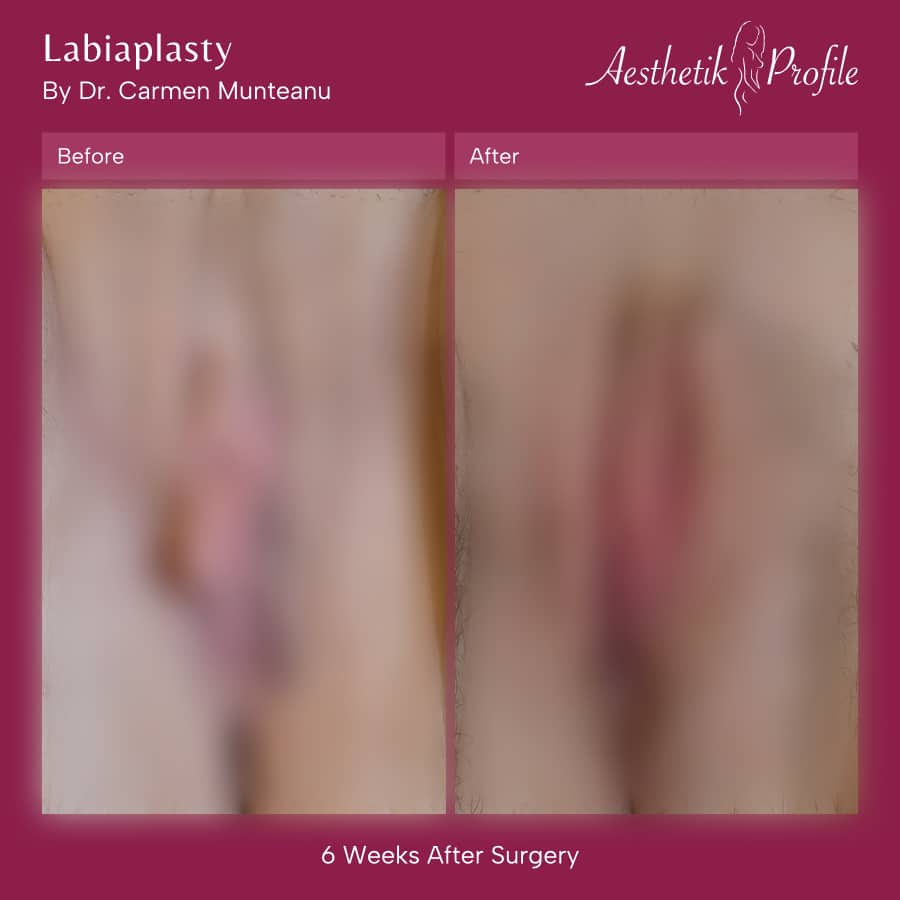
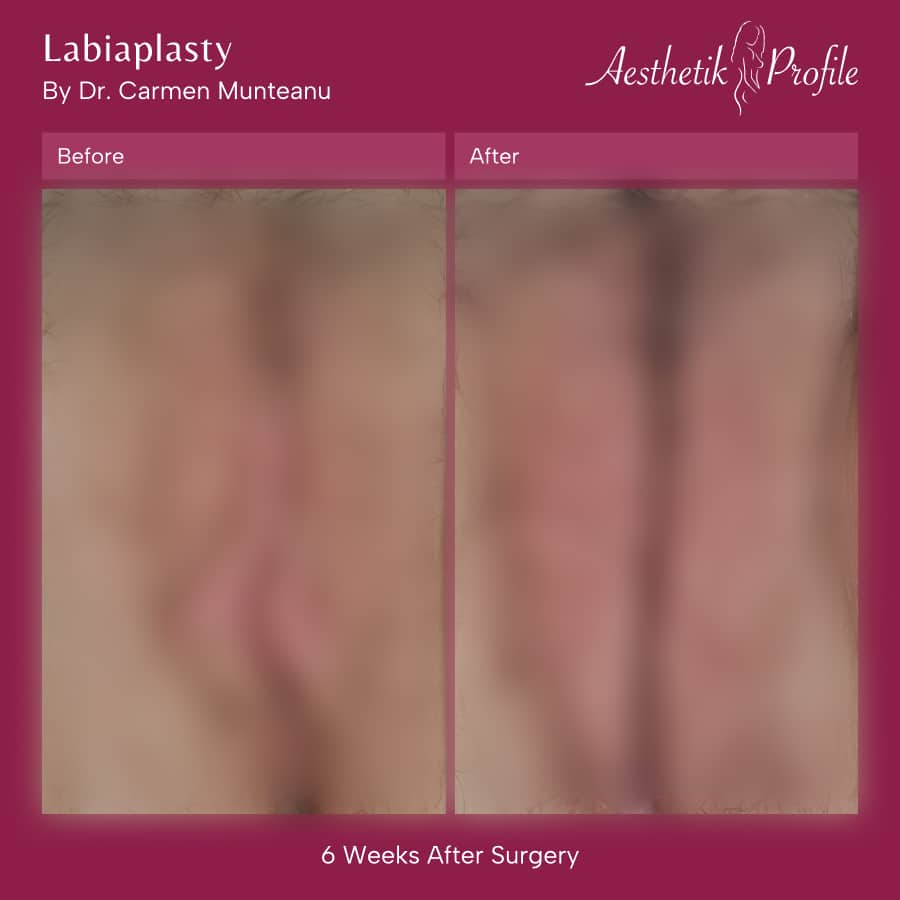
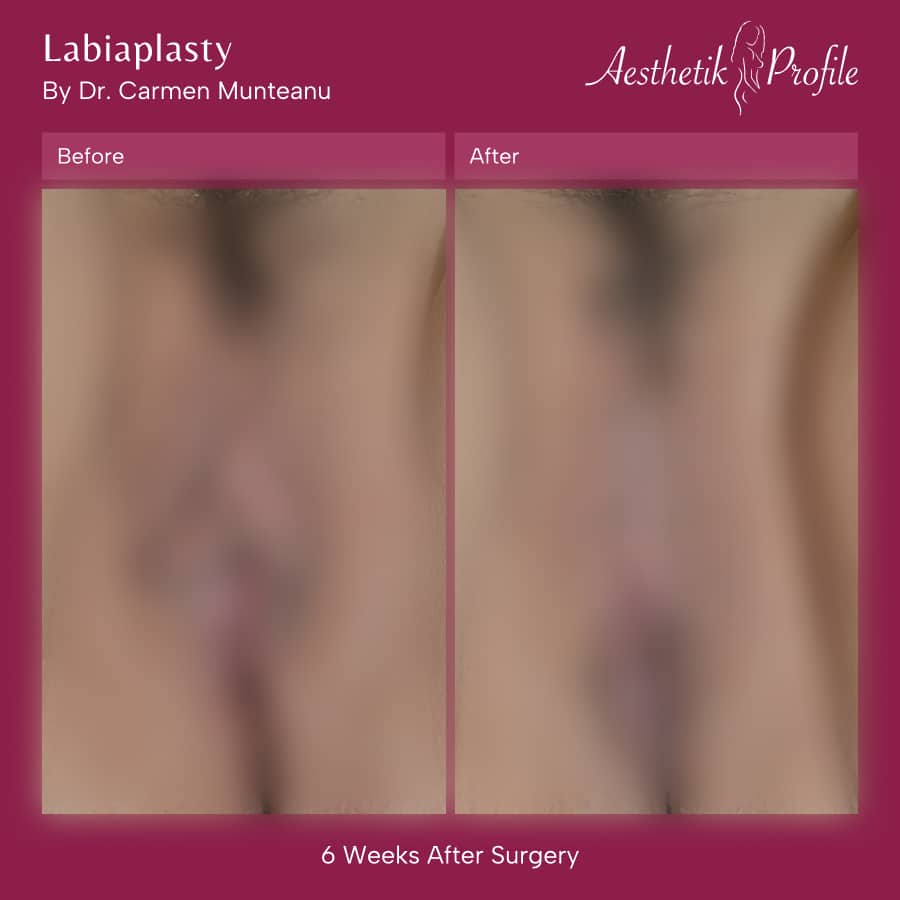









Click to see the Gallery of Labiaplasty Before and After Photos of Real patients by Female Plastic Surgeon Dr Carmen Munteanu – Experienced Labiaplasty Surgeon in Melbourne
Labiaplasty Surgical Procedure
Depending on your desired outcome, the techniques utilised for Labiaplasty will vary from one person to another. In general, this procedure is a day surgery.
Perineal Changes and Scar Revision
For women who have experienced perineal trauma or scarring from childbirth, particularly from episiotomies, additional surgical interventions can be performed during Labiaplasty. These may include addressing changes to the perineal area, removing scar tissue, or revising episiotomy scars to increase both function and appearance. These revisions help address discomfort and/or tightness that may have developed over time.
Clitoral Hood Reduction
Clitoral hood reduction is often performed alongside Labiaplasty to optimise aesthetic results or address functional concerns such as excess tissue that may cause discomfort. This procedure involves reducing and reshaping the tissue surrounding the clitoris for a more aesthetically pleasing appearance while preserving sensitivity. It is an optional addition, tailored to the patient’s individual anatomy and goals.
The wedge technique
The Wedge technique is a strategic and effective approach used in Labiaplasty to address concerns related to the size, shape or asymmetry of the labia minora. This method involves removing a partial-thickness wedge of tissue from the central portion of the labia minora. Unlike the trim technique, this technique preserves the edge of the labia.
Surgical Details of the Wedge Technique
- Incision and tissue removal: A strategically planned V-shaped incision is made in the middle third of the labia minora. This allows for the removal of excess tissue while maintaining the border. This addresses both the length and the width and can incorporate extensions into clitoral hood or perineum if needed. It’s a highly individualised approach to achieve personalised results and address particular problems.
- Multilayer closure: The closure is performed in multiple layers. This reduces tension on the incision line, promotes optimal healing and reduces scarring
- Preservation of Sensitivity: The wedge technique avoids disruption of the labial edge and its delicate nerve ending, preserving sensation and aiding recovery.
- Clitoral Hood Integration (optional): For patients requiring clitoral hood reduction, the procedure can be integrated with the wedge technique to achieve a cohesive and aesthetically pleasing result.
Dr Carmen will recommend a customised treatment plan based on your unique anatomy, and desired results. All stitches used in this procedure will be dissolvable.
Recovery after Surgery
In general the recovery time for Labiaplasty is between two and four weeks. You will be provided with personalised instructions on how to care for the surgical site, and follow-up consultations with Dr Carmen.
Generally, immediately after the surgery, patients can expect some swelling, bruising, and discomfort in the treated area. Pain relief medications and ice packs are usually prescribed to help manage these symptoms. To reduce irritation, it is recommended to wear loose-fitting underwear during the initial healing phase.
During the first few days post-surgery, it is important to rest and avoid strenuous physical activities. This includes refraining from heavy lifting, exercise, or sexual intercourse for at least 4-6 weeks to make sure the surgical site heals without complications. Patients should avoid any activity that could cause stress or strain on the area during this period.
Maintaining proper hygiene is crucial in the recovery process. You will be instructed on how to cleanse the surgical area, typically with mild soap and water. It is essential to avoid using any harsh or scented products until healing is complete to prevent irritation or infection.
Follow-up appointments with your surgeon will be necessary to monitor the progress of your healing and make sure you are not experiencing any complications. If non-dissolvable stitches were used, they will usually be removed during these visits, typically one to two weeks after the surgery.
Swelling and mild discomfort may persist for a few weeks, and the treated area may be sensitive for some time. These symptoms are part of the healing process, and they should gradually subside as time goes on. Full recovery generally takes about 6-8 weeks, during which you should continue to avoid activities that may cause trauma to the area.
By adhering to your surgeon’s post-operative instructions and attending follow-up appointments, you can optimise your results and reduce the risk of complications.
It is important that care be taken during healing to not overdo anything in the area as it can expose a very sensitive part of the anatomy, which can then require difficult and delicate reconstructive surgery.
Longer-Term Results
Dr Carmen’s technique using magnification helps optimise results and her use of dissolvable sutures helps to achieve healing with limited discomfort.
The results of surgery are typically long-lasting, as long as patients maintain an active lifestyle and avoid significant weight fluctuations. Once fully healed, the reshaped labia should retain their new form, offering long-term physical comfort and a more balanced aesthetic.
Changes such as ageing or hormonal fluctuations (including those from childbirth or menopause) may affect the appearance of the labia over time. However, the impact of these changes tends to be less significant than before the surgery, as the excess tissue has been removed and the labia are reshaped for a more functional and aesthetically pleasing appearance.
Risks and Complications of Labiaplasty
As with any surgical procedure, Labiaplasty carries certain risks and potential complications. While the majority of patients experience successful outcomes, it is important to be aware of the possible risks, including:
- Infection: Any surgery that involves incisions carries a risk of infection. Although this risk is low, proper aftercare and hygiene are critical in preventing infection. It’s important patients follow the surgeon’s instructions closely to reduce this risk.
- Bleeding: Bleeding during or after the surgery is a potential risk, some patients may experience bruising or swelling in the area, which typically resolves over time.
- Scarring: While Labiaplasty aims to alter the labia into a more aesthetically pleasing appearance, there is always the potential for scarring. Scarring is typically well-concealed, but the extent of scarring varies depending on individual healing processes and the surgeon’s technique.
- Numbness or Altered Sensation: Some patients may experience temporary numbness or altered sensation in the genital area after surgery. This can occur as a result of nerve involvement during the procedure. In most cases, sensation returns over time, but there is a small risk of permanent sensory changes.
- Wound Healing Problems: Although rare, some patients may experience delayed healing/wound dehiscence (opening of the wound), which can increase the risk of infection or require additional treatment.
- Asymmetry: While Labiaplasty aims to increase symmetry, there is a possibility that the labia may not be symmetrical after surgery. In some cases, patients may need revision surgery to optimise results.
It is essential for patients to discuss risks with Dr Carmen prior to undergoing Labiaplasty. A thorough consultation, including medical history review and understanding of personal goals, can help reduce complications. For a full list please visit our risks and complications page.
How much does a Labiaplasty Cost in Melbourne? Surgery Costs and Hospital Fees
The cost of a Labiaplasty in Melbourne can vary depending on several factors, including the surgeon’s fees, hospital costs, and the complexity of the procedure.
It’s important to note that Labiaplasty is often considered a cosmetic procedure, which means it may not be covered by Medicare or private health insurance.
When consulting with a surgeon, be sure to ask about the total cost of the procedure, including any additional fees or expenses. This will help you understand the financial commitment and make sure you are getting a fair and transparent price for the surgery.
By carefully considering these factors and discussing them with your surgeon, you can make an informed decision about whether Labiaplasty is the right choice for you.
Find out more about Labiaplasty Payment Plans, Prices and Consultation Fees
Your Consultation with Dr Carmen
At your pre-operative consultation Female Specialist Plastic Surgeon Dr Carmen Munteanu will listen carefully to your questions and goals, and conduct an examination before advising of your options and her recommendations. If you have any concerns, please feel free to bring them up with Dr Carmen. There’s no such thing as a silly question.
Dr Carmen will discuss the surgical risks and possible complications of surgery with you in detail during your consultation.
Further Reading – Medical References
- Patient- Labiaplasties – what are they and are they ever medically necessary?
- Aesthetic Surgery Journal- A Retrospective Study of the Psychological Outcomes of Labiaplasty
- American Society of Plastic Surgeon- What is a labiaplasty? Female Genital Procedures
- Aesthetic Surgery Journal- Motivations, Expectations, and Experiences of Labiaplasty: A Qualitative Study






